You don’t need another blogpost about Spain’s typical or most famous dishes but we do want to share our checklist of 10 unmissable dishes in Spain and when, where and how to order them! You see we’ve been planning itineraries throughout Spain since the year 2000, so here at Totally Spain we’ve learned a lot about the Spanish dishes that people expect to eat but can’t find or even worse – don’t enjoy. And we’ve added in a few dishes that our clients have enjoyed eating but wouldn’t have ordered without a tip-off from us.
10 Unmissable Dishes in Spain

You’ll need to do a bit of homework to enjoy Spain’s best known dish! photo credit: IMG_4683 via photopin (license)
1 Paella – a treat for all originating from Valencia
It’s Spain’s most famous dish and rightly so but be very careful where you order it. Obviously it’s generally best to avoid ordering it at restaurants that show photos of their food outside. (We generally recommend skipping these places entirely). This is one dish that requires research. Ask for help from a local. Paella takes about 40 minutes to make from scratch so plan to order some tasty starters to share while waiting. The only exception here is when it appears on a ‘menu del dia‘ when it is pre-prepared in batches and while it may be acceptable, it won’t be the best you’ll ever try. Generally speaking, the closer you are to the rice-producing province of Valencia – home to most Spanish rice dishes – the more authentic it is, although there are always exceptions to this rule! Wherever you get to taste it, we’d suggest you wash it down with a lovely crisp white wine especially if it’s a seafood paella. Cava also goes well. Of course, a decent Rioja will also taste great – especially if it’s a meat based paella. Read our detailed post on paella here for recipes, videos and tips on where to order this great dish.
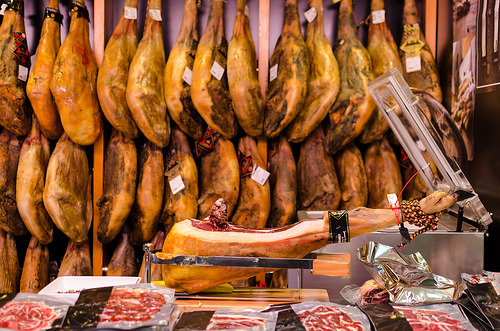
It’s really easy to enjoy great ‘jamon’ in Spain! photo credit: Valencia city via photopin (license)
2 Jamon – a culinary delight best known from Extremadura
This is one that you can try at the airport bar in a sandwich, later for lunch with a salad and in the evening as you bar hop. The quality will vary hugely as will the price tag as you’d expect but it’s hard to get an awful jamon. Our favourite time to try jamon is in the early evening – around 8pm which is before dinnertime in Spain. (Check out our post on Spanish mealtimes here.) That’s when we like to order a glass of Ribera, Toro or even something from Extremadura – Spain’s Iberian pig capital – such as Habla del Silencio. If you are planning to eat a sit-down meal later and just want an aperitivo sized taster of jamon, order a ‘media racion’ which is a half platter normally served with bread or small toasted breadsticks known as ‘picos’. If you are asked what type of ‘jamon’ you want, you’re generally being asked how much you want to spend. For everyday consumption, we’re usually happy with paleta iberico which is the front leg of a decent Iberia pig. For a special occasion, we order jamon iberico de bellota which is the back leg of an animal that has been grazing on acorns – the crème de la crème. (We’d even consider having a gran reserva wine with this, the finest of hams!) Expect to pay accordingly – but it is so so worth it when you want to taste the sublime! But only order this in a decent deli, food market, bar or restaurant that has quite a few hams hanging from the ceiling. If you are paying top dollar, you want to taste it in the very best of conditions. We always recommend attending a food tour in Spain where you usually get an overview of the types of jamon as well as a jamon tasting. Check out our post on gastronomy tours for more info.
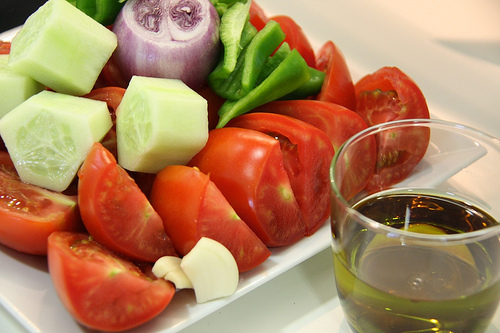
You want to know the best ingredients went into your gazpacho and they look a bit like this! photo credit: Ingredientes para el gazpacho via photopin (license)
3 Gazpacho – a refreshing treat originating from Andalucia
Here is another Spanish classic that is surprisingly difficult to order out in Spain. It’s a tricky one because you want gazpacho that is freshly made – and it’s become rather easy to pick up a litre of industrially produced stuff in the supermarkets here. We recommend ordering gazpacho at the more traditional restaurants and hotels such as the Parador chain of hotels in Spain. You’ll find this wonderfully refreshing cold soup served with a wonderful array of fresh garnishes. In recent years, this classic has been re-interpreted by many chefs who have created the strawberry gazpacho, the watermelon gazpacho and even an avocado gazpacho – although you’ll struggle to find those available generally. You will come across gazpacho’s first cousin, salmorejo, also from Andalusia, which generally is just made from tomatoes and garlic with breadcrumbs so it’s a thicker soup. What do you drink with a gazpacho? Generally, it’s hot if you are having a cold soup such as this and it often comes served in a glass rather than a bowl so it’s a drink in itself. If you’re having it as a first course in a restaurant and want to accompany it with something, we’d go for a dry chilled white or a manzanilla sherry. The salmorejo can handle something a bit heartier such as a red wine if you are continuing with a red for your second course.
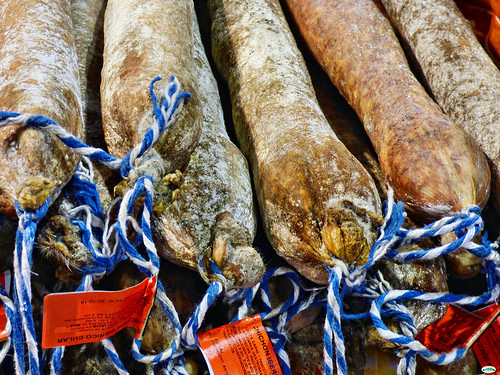
Look for these signs of these in your supermarket, deli or breakfast bar – not the stuff that comes in plastic! photo credit: Salchichón ibérico via photopin (license)
4 Chorizo – Plus some of Spain’s Other Tempting Cold Cuts
Chorizo is cropping up more and more in recipes here and abroad and is available in almost every supermarket across Western Europe. But there is a world of difference to what you find in a sealed plastic packet (here or there) and the slices of chorizo you order at a deli or bar here. And while you are standing at that deli counter, there are lots more cold cuts or ’embutido’ to try when in Spain. For example, in Catalonia there’s the local cured sausage called fuet. In Leon and nearby, you have to order the ‘cecina’ which is a cured beef – and one of our personal favourites. And you’ll find ‘salchicon’ which is another cured sausage readily available everywhere too. Remember when in a supermarket or deli that there are two types of chorizo – the large one that is sliced for immediate consumption and the smaller ones that are used in cooking. We heartily recommend you try some of the dishes that use this smaller chorizo – including ‘chorizo a la sidra’ which is chorizo cooked in cider typical to Asturias. We also love croquetas made with a good chorizo. And the wonderful ‘patatas a la riojana’ which is a chorizo and potato stew from the Rioja region. It’s also a handy one to pop on the BBQ if you are self-catering in Spain. Wash it down with a nice Vivanco or Baigorri from Rioja, a cider if you are in Asturias and if you are in Leon or simply just having cecina, try a nice wine from the DO Toro, Bierzo or Tierras de Leon which are made from the more unusual Prieto Picudo and Mencía grapes.

If you want to know what to order on a menu, get out and see what the chefs are buying – at your local fish market… photo credit: Mercado de Pontevedra via photopin (license)
5 Spain’s Fish – Local, Seasonal & Super Fresh
It’s impossible to pick one fish dish in Spain – there is so much diversity in what is served from one region to the next. For example if you are in the North during the summer months we’d suggest Northern tuna steak called ‘bonito del Norte’. Maybe pair this with one of the lesser known Cantabrian white wines from Bodegas Vidular. If you are in the Basque Country, try the ‘bacalao al pil-pil’ which is salt cod prepared in oil. Down south – you’ll find lots of swordfish and tuna – plus deep fried ‘pescaito frito’ that is hugely popular at the fiestas and ferias. And we adore fish baked in salt which we’ve enjoyed in Murcia. Wherever you are, you’ll find hake (merluza) is always plentiful and tasty. ‘Rape’ (pronounced rah-pey) which is monkfish is another more expensive but widely available fish. If you don’t know what to order, ask the waiter or see what your fellow diners are ordering. Remember, you’ll find very different fish on offer in Winter compared to Summer. The best way to get a sense of what is in season is by visiting the local fish market. If you see sardines selling by the cartload, you know you need to order ‘sardinas’ when you are out. In terms of what to drink with your fish, you won’t go wrong with a crisp white – we adore the Albarinos from the Rias Baixas such as Pazo Senoranz which we visited in Galicia, but we also enjoy a Verdejo from Rueda. If your fish is local – why not make your wine the same – if you’re having bacalao al pil-pil, you have to try a txakoli, the tart white typical to the Basque Country! If you feel like something out of this world, you might try getting your hand’s on a bottle of Castillo Ygay White from 1986 – it just achieved 100 Parker Points – the first Spanish white to ever gain that score. You’d probably want to pair it with some real ‘angulas’ called elvers or baby eels – which are the most expensive fish you can buy in Spain. If you aren’t feeling so flush, try ‘gulas’.
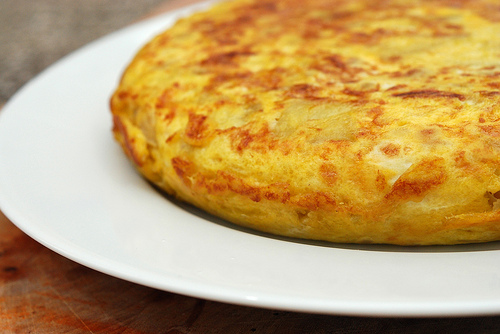
Best enjoyed between 10am and noon! If you see others tucking in, you know it’ll be tasty! photo credit: Tortilla via photopin (license)
6 Tortilla – a Spanish classic!
This is another of those mythical dishes which you simply have to try in Spain – but there is a good time and a good place to get the best and that’s generally in a busy cafe or bar between 10am and 12 noon. Only order it in a bar where you see others tucking in. Pro-Tip: Do not order it after 2pm and it may have been sitting around since the early morning and will have dried out a little. Whatever you do, do not order one that is sealed in plastic and sold in the supermarkets – it bears no resemblance to what you should be tasting. Wondering what to drink with tortilla? We wash it down with a coffee if it’s before 12 and perhaps a refreshing beer or clara (beer with lemonade) after midday. To read more about this iconic dish, check out our detailed post on Spanish omelette which includes recipes, tips on how to order it out and images of giant tortillas.
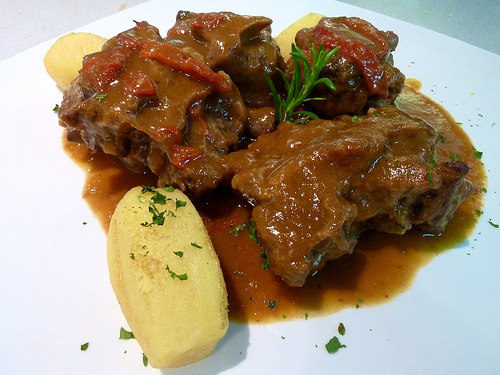
Rarely photogenic, but these slow cooked meat dishes such as this ‘rabo de toro’ will stay with you forever! photo credit: Rabo de Toro en salsa via photopin (license)
7 Unusual Meats & Cuts – Spain’s Melt in Your Mouth Slow Food
Spain isn’t famous for its slow-cooked dishes despite excelling at them and we love ordering them out. If you pick your restaurant carefully, you’ll find everything from tender, melt-in-your-mouth beef, rabbit, pork, wild boar, bull and venison. We are massive fans of the slow cooked beef cheek called ‘carrilleras’ and always order it when we see it on the menu. Another classic would be the rabo de toro – which translates as bull’s tail – which is again – unmissable. If you find yourself in rural terrain, you may come across wild boar and venison stews. When we visit a small village in Cantabria called Barcena Mayor we always order ‘estofado de jabali’ which is a wild boar stew and ‘estofado de venado’ which is a venison stew. All of these slow-cooked meats are hearty dishes that can be paired with a very hearty red wine. If you are in a simple rural restaurant, keep it simple and have something local or a Rioja or Ribera which are usually available everywhere. If you are somewhere with a lot of wine on offer, we’d try to pair the food with the wine. Something like a Somantano red which actually translates as ‘beneath the mountain’. Enate is the best known Somantano brand but you’ll find there are lots of wineries producing great reds under this DO. If it’s a special occasion, make sure it’s a reserva. The meal can more than handle it.

This octopus called pulpo seasoned with pimenton de la Vera is another of those dishes that can take over your senses and can easily become the best dish of the holiday! photo credit: Pulpo a la brasa via photopin (license)
8 Spain’s Seafood – Try As Many Ways as Possible
Spanish tapas bars abroad tend to favour the ‘gambas al ajillo’ and don’t get us wrong – we love garlicy prawns as much as you do – but most of them are imported in from who knows where so it’s not 100% Spanish in that sense. We’d prefer you to try something from here – whether its squid (calamares), clams (almenjas), octopus (pulpo), mussels (mejillones) or crab which is ordered here as ‘centollo’ or ‘necora’. Scallops (vieira) are a must-order if you are near Galicia. And don’t just try each type of seafood once – try each twice. For example try the calamares cooked in a light batter but also make some room for the small individual squid called chipirones in their ink (en su tinta) which are wonderful. Try the mussels cooked in garlic one day and compare them in a vinaigrette the next. As we’ve already suggested, try visit a fish market in the area to see what the locals are buying and that’s what you need to order for lunch or dinner. If you want to shock yourself, check out the price of the ‘percebes’ which are goose barnacles and the most expensive seafood in Spain. Again, white wine reigns here with seafood– but we’d also suggest a vermouth – especially if you are bar hopping for a lunchtime aperitivo at the weekend.

Comfort food Spanish style. You many need a nap after these Asturian beans and sausage! photo credit: Fabes al estilo de mi madre via photopin (license)
9 Chickpeas, Beans & Lentils – Spain’s Simplest but Often Overlooked Dishes
After a day or two of tapas, we always recommend sampling the Spanish stews made from pulses. These are often on the ‘menu del dia’ which is a fixed-price three course meal. Dishes vary from region to region but the most common are lentils, chickpeas and white or red beans. We love ordering them out because they tend to be simple home-cooked dishes. It’s more about how they are cooked rather than the price of the individual ingredients (although you can go wild with posh beans if you want). When you order one of these dishes in the smaller towns and cities, you are often served a huge bowl in the centre of your table from which you help yourself – which is wonderful if you have a hearty appetite! Our favourite are ‘lentejas’ which are a small dark brown puy type lentil stewed with leek, carrots, onions, garlic and chorizo sausages. Perfect comfort food! We’d pair these with a house red which is generally a cosecha or crianza which is nearly always included in the set-price menu deal. If you are doing the Camino de Santiago, you’ll find pulses frequently crop up in the bars and restaurants that served the Pilgrim’s dish of the day.

Only order churros when you see others eating them in large quantities! That’s your guarantee of freshness! photo credit: y Churros de Madrid (8) via photopin (license)
10 Churros & Chocolate – Spanish Street Food at its Sweetest
We couldn’t finish this list without at least one sweet offering, could we? Although it might seem like the simplest thing to order to a Spanish person, for a visitor, it’s rarely a straightforward purchase. Some places serve churros for breakfast and if you see a place doing this in large volumes – then go ahead and check it out. But we find the safest advice is to order them from a churro van in a square – especially when you see a queue – that’s when you know they are freshly made and taste the best. Churros vans typically open for business in the late afternoon and stay open until late during holidays and at weekends. If you don’t coincide with one, you will find a few cafes that offer up this classic in very degrees of success. There are the national chains such as Valor that made the large churro –called a ‘porra’ but we think you are better off asking a local (whether that’s us, your concierge or your expert guide) as each village, town and city has at least one place where the churros are out of this world. And, in case it needs saying, yes, of course you need to accompany your churros with a cup of thick hot dark chocolate for dunking.
If you want to read more about Spain’s gastronomy, check out all our blogposts on Spanish Food & Drink 
